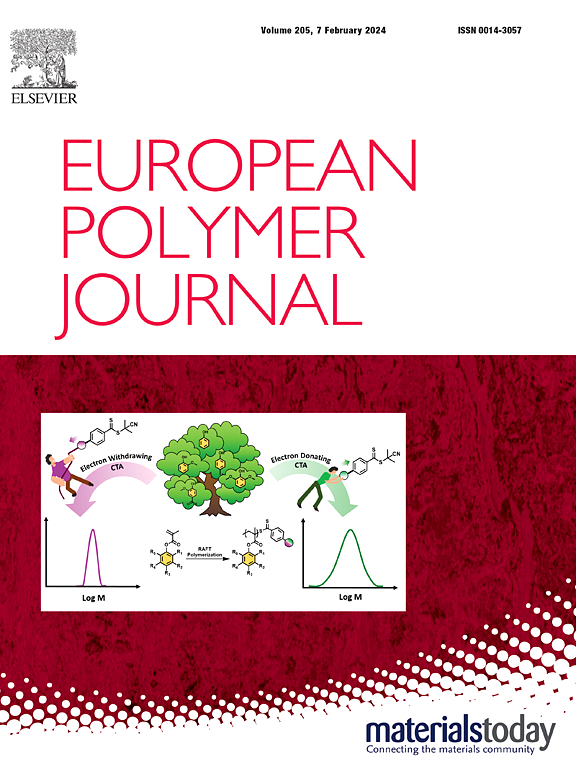New water-soluble coumarin-ketone-pyridium salts photoinitiators for antibacterial coatings under visible LED photocuring
IF 5.8
2区 化学
Q1 POLYMER SCIENCE
引用次数: 0
Abstract
With the increasing global emphasis on public health, personal hygiene, and environmental safety, the development of effective strategies to inhibit microbial growth and transmission has become a critical research focus, driving rapidly expanding demand for antibacterial materials across multiple fields. UV-photocured antibacterial coatings have gained widespread adoption due to their fast curing rates, low energy consumption, and environmentally friendly characteristics. However, commercially available water-soluble photoinitiators such as Irgacure 2959, while exhibiting certain photosensitivity and low cytotoxicity, demonstrate poor compatibility with visible LED light sources. Herein, we present a novel class of visible LED-sensitive coumarin-ketone-pyridinium salt photoinitiators with varied anions, systematically investigating their photoinitiation performance and antibacterial properties. Our findings reveal that these dual-functional photoinitiators in combination with coinitiator N-phenylglycine (NPG) enable efficient and rapid photocuring when exposed to visible LED irradiation, with the water-borne coatings demonstrating excellent antibacterial activity against Escherichia coli and Staphylococcus aureus. Notably, both the photoinitiators and resultant coatings exhibit good hemocompatibility, underscoring their promising potential for antibacterial coating applications.

新型水溶性香豆素酮吡啶盐光引发剂在可见光LED光固化下用于抗菌涂层
随着全球对公共卫生、个人卫生和环境安全的日益重视,开发有效的策略来抑制微生物的生长和传播已成为一个关键的研究重点,推动了抗菌材料在多个领域的需求迅速扩大。紫外光固化抗菌涂料因其固化速度快、能耗低、环保等特点而得到广泛采用。然而,市售的水溶性光引发剂,如Irgacure 2959,虽然具有一定的光敏性和低细胞毒性,但与可见LED光源的兼容性较差。在此,我们提出了一类新的具有不同阴离子的可见led敏感香豆素酮吡啶盐光引发剂,系统地研究了它们的光引发性能和抗菌性能。我们的研究结果表明,这些双功能光引发剂与协同引发剂n -苯基甘氨酸(NPG)结合,在可见光LED照射下可以实现高效、快速的光固化,水性涂料对大肠杆菌和金黄色葡萄球菌表现出优异的抗菌活性。值得注意的是,光引发剂和所得涂层都表现出良好的血液相容性,强调了它们在抗菌涂层应用方面的巨大潜力。
本文章由计算机程序翻译,如有差异,请以英文原文为准。
求助全文
约1分钟内获得全文
求助全文
来源期刊

European Polymer Journal
化学-高分子科学
CiteScore
9.90
自引率
10.00%
发文量
691
审稿时长
23 days
期刊介绍:
European Polymer Journal is dedicated to publishing work on fundamental and applied polymer chemistry and macromolecular materials. The journal covers all aspects of polymer synthesis, including polymerization mechanisms and chemical functional transformations, with a focus on novel polymers and the relationships between molecular structure and polymer properties. In addition, we welcome submissions on bio-based or renewable polymers, stimuli-responsive systems and polymer bio-hybrids. European Polymer Journal also publishes research on the biomedical application of polymers, including drug delivery and regenerative medicine. The main scope is covered but not limited to the following core research areas:
Polymer synthesis and functionalization
• Novel synthetic routes for polymerization, functional modification, controlled/living polymerization and precision polymers.
Stimuli-responsive polymers
• Including shape memory and self-healing polymers.
Supramolecular polymers and self-assembly
• Molecular recognition and higher order polymer structures.
Renewable and sustainable polymers
• Bio-based, biodegradable and anti-microbial polymers and polymeric bio-nanocomposites.
Polymers at interfaces and surfaces
• Chemistry and engineering of surfaces with biological relevance, including patterning, antifouling polymers and polymers for membrane applications.
Biomedical applications and nanomedicine
• Polymers for regenerative medicine, drug delivery molecular release and gene therapy
The scope of European Polymer Journal no longer includes Polymer Physics.
 求助内容:
求助内容: 应助结果提醒方式:
应助结果提醒方式:


